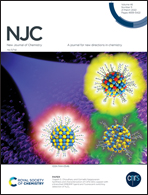A microporous anionic metal–organic framework for aqueous encapsulation and highly reversible sensitization of light-emitting Tb3+ ions†
Abstract
A novel porous anionic MOF, [H2N(CH3)2][KZn2(bpyp)(dcba)2]·DMF·1.5H2O (Me2NH2@MOF-1), having exchangeable cations in 1D channels, has been synthesized and characterized. Specifically, the anionic MOF was shown to be able to serve as both a host and an antenna for protecting and sensitizing extra-framework light-emitting Eu3+/Tb3+ ions aqueously encapsulated within the MOF pores. Furthermore, the Tb3+ uptake and release was found to be a reversible process and the cationic Tb3+ can be gradually released.



 Please wait while we load your content...
Please wait while we load your content...